Twist on gene-editing tool may speed studies of gene function
Researchers have repurposed the gene-editing tool CRISPR to dial down a gene’s activity in select subtypes of neurons in mice.

Researchers have repurposed the gene-editing tool CRISPR to dial down a gene’s activity in select subtypes of neurons in mice1.
The new technique also allows scientists to quiet the activity of multiple genes at once, giving them the ability to explore the functions of combinations of genes.
The approach, described 5 February in Nature Neuroscience, could be used to study the functions of genes tied to autism.
Most techniques for silencing multiple genes in mice are time-consuming and expensive, says co-lead investigator Jun Yao, principal investigator at the School of Life Sciences at Tsinghua University in Beijing. “That’s why I wanted to develop a fast tool, so that we can generate very rapid mouse strains.”
Researchers could use the tool to suppress genes linked to autism, alone or in combination, in specific regions or cell types of the brain. They could then assess the effects on mouse behavior.
“I think it’s going to be really useful,” says Carlos Portera-Cailliau, professor of neurology and neurobiology at the University of California, Los Angeles, who was not involved in the work.
CRISPR twist:
CRISPR allows researchers to create mutations in or delete parts of genes. It uses strands of RNA that guide a scissor-like enzyme to make cuts at specific sites in a genome.
The new work relies on a version of CRISPR that includes inactivated scissors and a bulky protein that blocks the cell’s machinery for expressing genes. This approach, called CRISPR interference (CRISPRi), debuted in 2013 and enables researchers to dampen genes’ activity2.
Yao’s team optimized CRISPRi to suppress genes in cultured neurons from the mouse hippocampus, which controls learning and memory. They created harmless viruses that ferry the CRISPRi system into neurons. They dampened the expression of four genes, one at a time, that are critical for the release of neurotransmitters.
This approach is faster and more effective than RNA interference (RNAi), a popular technique that uses RNA snippets to turn off genes, the researchers found.
“It’s clearly better than RNAi, for sure,” says Yong-Hui Jiang, associate professor of pediatrics at Duke University in Durham, North Carolina, who was not involved in the work.
Memory tests:
Yao and his team then created two additional viruses that transport CRISPRi into specific types of neurons. One targets a type of ‘excitatory’ neuron that enhances neuronal activity via the neurotransmitter glutamate; the other targets ‘inhibitory’ neurons that dampen neuronal activity via gamma-aminobutyric acid.
The researchers injected mice with one of the two viruses, delivering CRISPRi into a brain region called the dentate gyrus — a part of the hippocampus. They targeted a gene called SYT1, which triggers neurotransmitter release when a neuron fires. They then isolated neurons and cultured them.
Neurons of either type transmit weaker electrical messages when they lack SYT1, the researchers found. They then explored whether SYT1 suppression affects mouse behavior.
Silencing SYT1 in excitatory cells impairs the animals’ learning and memory, as measured by three behavior tests. By contrast, silencing the gene in inhibitory cells improves their performance on these tests.
Suppressing the gene may shift the balance between excitatory and inhibitory signaling in the hippocampus, Yao says. The technique may help researchers test a leading theory of autism: that the condition originates from a relative lack of inhibition in the brain.
However, experts note that Yao’s team did not confirm an imbalance by measuring activity in the neuronal networks.
Yao’s team also designed a virus that suppresses SYT1 and four other genes at once in live mice.
The most exciting aspect of the technique is its ability to silence multiple genes, says Guoping Feng, professor of brain and cognitive sciences at the Massachusetts Institute of Technology, who was not involved in the work. But researchers still need to determine whether the effect varies from one cell to the next.
“You may have a very different level of suppression in each cell,” Feng says. “It’s really difficult to precisely control in each cell — that’s the problem.”
Yao says his team is testing the specificity and accuracy of their technique. They also plan to test the approach in neurons generated from people with autism.
References:
- Zheng Y. et al. Nat. Neurosci. Epub ahead of print (2018) PubMed
- Qi L.S. et al. Cell 152, 1173-1183 (2013) PubMed
Recommended reading

Developmental delay patterns differ with diagnosis; and more

Split gene therapy delivers promise in mice modeling Dravet syndrome

Changes in autism scores across childhood differ between girls and boys
Explore more from The Transmitter

Smell studies often use unnaturally high odor concentrations, analysis reveals

‘Natural Neuroscience: Toward a Systems Neuroscience of Natural Behaviors,’ an excerpt
